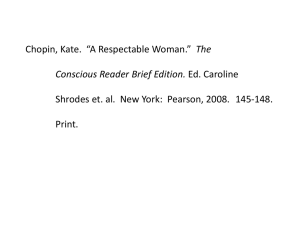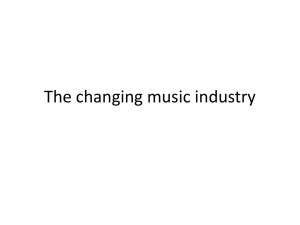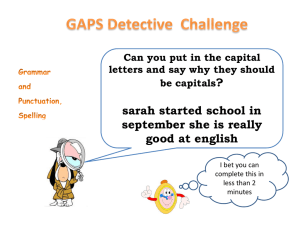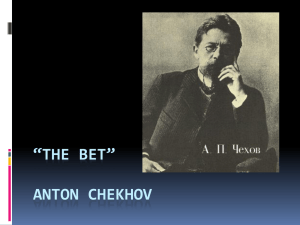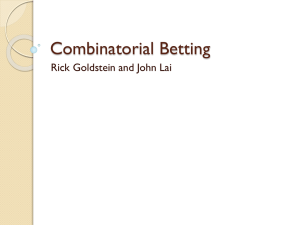Martingale System.
advertisement
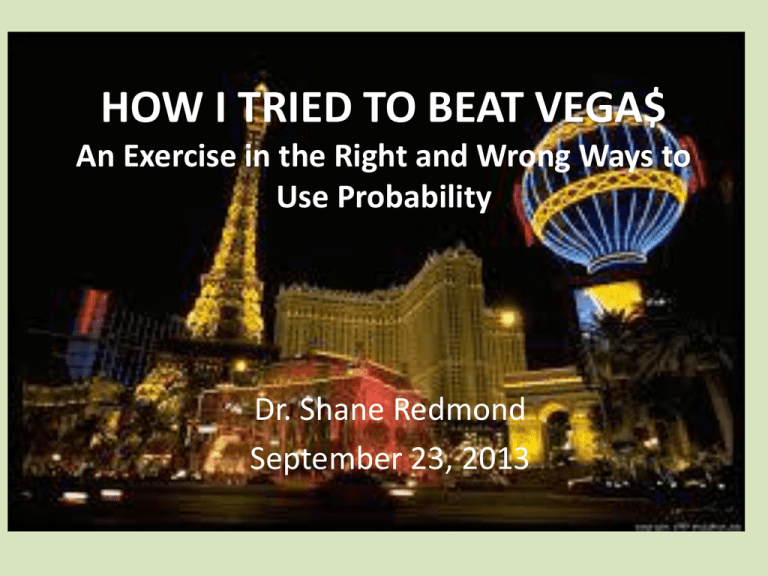
HOW I TRIED TO BEAT VEGA$ An Exercise in the Right and Wrong Ways to Use Probability Dr. Shane Redmond September 23, 2013 Disclaimer: No EKU funds were used at casinos to research this talk. This talk is also not an endorsement of gambling. The game: Roulette Invention has been attributed to mathematicians Blaise Pascal, Don Pasquale, and many others. The wheel: 38 numbered slots 18 red 18 black 0 and 00 are green in American roulette (European roulette has only one 0, 37 slots) The bets: Bet on one individual number Payout is 35 to 1 Meaning if you bet $1 and win, you will be given $36, for a net gain of $35. P(lose) = 37/38 =.9737 The bets: Corner bets Payout is 8 to 1 P(lose) = 34/38 = .8947 Outside bets: Columns Payout is 2 to 1 P(lose) = 26/38 = .6842 Outside bets: Color, parity, high/low Payout is 1 to 1 P(lose) = 20/38 = .5263 So our odds are best with the outside bets Let’s consider playing against a streak. For example, if we bet red, let’s bet red again because the probability of not seeing red twice in a row is (20/38)*(20/38) = .2770. In fact, the probabilities of not seeing red STREAK PROBABILITY 1 .5263 2 .2770 3 .1458 4 .0767 5 .0404 6 .0213 7 .0112 8 .0059 9 .0031 10 .0016 11 .0009 20 38 𝑛 Gambler’s Fallacy Just because the wheel came up black last time, it does NOT make red MORE likely to come up the next time. The probability of red is the SAME on each spin, no matter the previous outcomes. This is called the “Gambler’s Fallacy” or “Monte Carlo Fallacy” after one crazy night in 1913 where black came up on the roulette wheel 26 times in a row. However, we’re not falling for the Monte Carlo Fallacy Flip a coin. P(heads) = ½ Flip a coin twice, P(heads twice) = ¼ So how do we take advantage of these favorable probabilities? If we bet $1, lose, and bet $1 again, we do not come out ahead. But, if we double the second bet to $2, we do come out ahead: -$ 1 - $ 2 + 2($ 2) = $ 1 Loss on Bet #1 Amount of Bet #2 Payout Bet #2 Overall profit Similarly, if we lose twice, double the third bet again to cover previous losses and ensure a profit. -$ 1 - $ 2 - $ 4 + 2($ 4) = $ 1 Loss on Bet #1 Loss on Bet #2 Amount of Bet #3 Payout Bet #3 Overall profit We can continue this process of doubling our bets to cover previous losses for streaks of any length. This method is an example of a Martingale System. First gained popularity in 18th century France. First studied mathematically by Paul Levy (1934). Named “martingale” by Jean Ville (1939). Table of bets to make betting against a streak STREAK PROBABILITY BET 1 .5263 $1 2 .2770 $2 3 .1458 $4 4 .0767 $8 5 .0404 $ 16 6 .0213 $ 32 7 .0112 $ 64 8 .0059 $ 128 9 .0031 $ 256 10 .0016 $ 512 11 .0009 $ 1024 𝑛−1 2 What problems do you see with our Martingale System? Practical problems: You need a large initial bankroll. STREAK PROBABILITY BET TOTAL BET PAID 1 .5263 $1 $1 2 .2770 $2 $3 3 .1458 $4 $7 4 .0767 $8 $ 15 5 .0404 $ 16 $ 31 6 .0213 $ 32 $ 63 7 .0112 $ 64 $ 127 8 .0059 $ 128 $ 255 9 .0031 $ 256 $ 511 10 .0016 $ 512 $ 1023 11 .0009 $ 1024 $ 2047 Sum of previous bets, or 𝑛 2 -1 Practical problems: The payout is small. STREAK PROBABILITY BET TOTAL BET PAID 1 .5263 $1 $1 2 .2770 $2 $3 3 .1458 $4 $7 4 .0767 $8 $ 15 5 .0404 $ 16 $ 31 6 .0213 $ 32 $ 63 7 .0112 $ 64 $ 127 8 .0059 $ 128 $ 255 9 .0031 $ 256 $ 511 10 .0016 $ 512 $ 1023 11 .0009 $ 1024 $ 2047 In all cases, the profit is only $ 1. The Martingale System is like a “reverse lottery” Lottery • We know the odds of losing are high. • Profit when we win: great (millions of $$) • Consequences of losing: small ($1-$2) Martingale system • We think the odds of losing become low. • Profit when we win: small (usually the initial bet) • Consequences of losing: great (may hundreds times the initial bet) Some ways around the small profit *Start with bets larger than $ 1 (Of course, this means a much bigger initial bankroll is necessary.) *Run several bets at once (For example, bet red and odd and high numbers, continuing the doubling only for the bets that lose) *Use other patterns other than doubling (For example, $ 1 -> $ 2 -> $ 5 -> $ 10 -> $ 20 -> $ 50 -> $ 100 -> $ 200 -> $400 …) Practical problems: Complementary Drinks The Hangover, 2009, Warner Bros. Practical problems: Table Limits Classic sign Modern digital sign Practical problems: Pit Boss 1995 – Universal Pictures Practical problems: Pit Boss $ 400 bet on red represented a risk of $ 1 + $ 2 + $ 5 + $ 10 + $ 20 + $ 50 + $ 100 + $ 200 + $400 = $788 for a profit of $ 12 Mathematical problems: The probability is never zero … because we do not have an infinite amount of time to play the game or an infinite budget. Mathematical problems *The probability of a streak occurring is not the best way to look at the outcomes. *Long streaks are not as uncommon as the probabilities suggest. Expected Value The expected value is the value one would “expect” to find if one could repeat a random process over an very large number of trials and take the average of the values obtained. EV = (profit from win) × (probability of win) + (amount of loss) × (probability of loss) Expected Value: one play EV = (profit from win) × (probability of win) + (amount of loss) × (probability of loss) $1 18 + −$ 1 38 20 −2 −1 = = 38 38 19 = −$ .05 Expected Value: streak of n plays Probability of win Probability of Amount of loss before a streak streak of n losses of n losses $1 20 1− 38 20 =1− 38 40 =1− 38 𝑛 20 + 38 𝑛 𝑛 −$ 2𝑛 − 1 𝑛 20 20 −2 + 38 38 𝑛 𝒏 𝟐𝟎 =𝟏− 𝟏𝟗 𝑛 𝑛 Expected Value: 1:1 outside bets STREAK PROBABILITY BET TOTAL BET PAID EXPECTED VALUE 1 .5263 $1 $1 - $ .05 2 .2770 $2 $3 - $ .11 3 .1458 $4 $7 - $ .17 4 .0767 $8 $ 15 - $ .23 5 .0404 $ 16 $ 31 - $ .29 6 .0213 $ 32 $ 63 - $ .36 7 .0112 $ 64 $ 127 - $ .43 8 .0059 $ 128 $ 255 - $ .51 9 .0031 $ 256 $ 511 - $ .59 10 .0016 $ 512 $ 1023 - $ .67 11 .0009 $ 1024 $ 2047 - $ .76 Outside bets: Columns Payout is 2 to 1 P(lose) = 26/38 = .6842 STREAK PROBABILITY BET TOTAL BET PROFIT PAID EXPECTED VALUE 1 .6842 $1 $1 $2 - $ .05 2 .4681 $1 $2 $1 - $ .09 3 .3203 $2 $4 $2 - $ .14 4 .2192 $3 $7 $2 - $ .19 5 .1500 $4 $ 11 $1 - $ .23 6 .1026 $6 $ 17 $1 - $ .28 7 .0702 $9 $ 26 $1 - $ .33 8 .0480 $ 14 $ 40 $2 - $ .38 9 .0329 $ 21 $ 61 $2 - $ .44 10 .0225 $ 31 $ 92 $1 - $ .49 11 .0154 $ 47 $ 139 $2 - $ .54 12 .0105 $ 70 $ 209 $1 - $ .60 13 .0072 $ 105 $ 314 $1 - $ .66 14 .0049 $ 158 $ 472 $2 - $ .72 15 .0034 $ 237 $ 709 $2 - $ .78 2:1 outside bets Expected Value: a recursive formula 𝑒𝑛 = Expected value for spin n 𝑒𝑛−1 = Expected value for spin n - 1 𝑝 = probability of a loss on this spin 𝑒𝑛 = 𝑒𝑛−1 + 𝑝𝑛−1 (𝑤𝑛 1 − 𝑝 + 𝑏𝑛−1 − 𝑏𝑛 𝑝) 𝑤𝑛 = profit for win on spin n 𝑏𝑛 = Sum of bets for spin n 𝑏𝑛−1 = Sum of bets for spin n -1 8:1 corner bets STREAK PROBABILITY BET TOTAL BET PROFIT PAID EXPECTED VALUE 1 .8947 $1 $1 $8 - $ .05 2 .8006 $1 $2 $7 - $ .10 3 .7163 $1 $3 $6 - $ .14 4 .6409 $1 $4 $5 - $ .18 5 .5734 $1 $5 $4 - $ .21 6 .5131 $1 $6 $3 - $ .24 7 .4591 $1 $7 $2 - $ .27 8 .4107 $1 $8 $1 - $ .30 9 .3675 $2 $ 10 $8 - $ .34 … … … … … … 39 .0131 $ 57 $ 510 $3 - $ 1.54 STREAK PROBABILITY BET TOTAL BET PROFIT PAID EXPECTED VALUE 1 .9737 $1 $1 $ 35 - $ .05 2 .9481 $1 $2 $ 34 - $ .10 3 .9231 $1 $3 $ 33 - $ .15 … … … … … … 35 .3932 $1 $ 35 $1 - $ 1.21 36 .3829 $2 $ 37 $ 35 - $ 1.26 … … … … … … 53 .2433 $2 $ 71 $1 - $ 1.81 54 .2369 $3 $ 74 $ 34 - $ 1.85 … … … … … … … … … … … … 116 .0453 $ 15 $ 508 $ 32 - $ 3.97 35:1 single number bets Are streaks that rare? We calculated earlier with a $ 511 bankroll, you could bet on red/black for a streak of up to 9 spins with a probability of not winning in those 9 spins of 20 9 =.0031 38 But how likely is it to hit a streak of 9 or more and losing our bankroll before we earn back our $ 511? Likelihood of hitting a bad streak So, our chances of not bankrupting (not hitting a streak of 9 or more against us) on the first 9 spins is 1 - .0031 = .9971. The probability of going bankrupt on each subsequent spin is 18 × .0031 = .001468 38 So, the probability of not going bankrupt after n > 9 spins is .9971 1 − .001468 𝑛−9 Likelihood of staying solvent after n spins Number of spins 9 Probability Not Bankrupt .9971 100 200 300 .8723 .7531 .6502 400 500 750 .5614 .4847 .3357 1000 .2325 Lessons learned Thanks!!! and … This Saturday 9/28 Bluegrass Undergraduate Mathematics Symposium (B.U.M.S.) Centre College in Danville FREE to undergraduates if register online by Sept. 24 (tomorrow!) Grad students – contact me for FREE registration FREE LUNCH TO ALL WHO PRE-REGISTER! http://web.centre.edu/bums/Home.html
